Papers by Francesco Buonocore
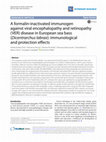
The European sea bass (Dicentrarchus labrax) is an important farmed fish species in the Mediterra... more The European sea bass (Dicentrarchus labrax) is an important farmed fish species in the Mediterranean area, very sensitive to the infection by encephalopathy and retinopathy virus (VERv), or Betanodavirus, which causes massive mortalities. Effective vaccines to fight the pathology are not yet available and in this work we describe a promising intraperitoneal immunization route against VERv of sea bass juveniles. We performed intraperitoneal and immersion immunization trials with a VERv (isolate 283.2009 RGNNV) inactivated by formalin, β‑propiolactone and heat treat‑ ment. Interestingly, the intraperitoneal immunization with formalin‑inactivated VERv induced a significant antigen‑ specific IgM production, differently from other inactivation protocols. However, the same formalin‑inactivated antigen resulted in very low IgM antibodies when administered by immersion. Following the intraperitoneal injection with formalin‑inactivated virus, the quantitative expression of the antiviral MxA gene showed a modulation of transcripts in the gut after 48 h and on head kidney after 24 h, whereas ISG12 gene was significantly up‑regulated after 48 h on both tissues. In immersion immunization with formalin‑inactivated VERv, a modulation of MxA and ISG12 genes after 24 h post‑treatment was detected in the gills. An effective uptake of VERv particles in the gills was confirmed by immunohistochemistry using anti‑VERv antibodies. Lastly, in challenge experiments using live VERv after intraperito‑ neal immunization with formalin‑inactivated VERv, we observed a significant increase (81.9%) in relative survival per‑ centage with respect to non‑immunized fish, whereas immersion immunization resulted in no protection. Our results suggest that intraperitoneal immunization with formalin‑inactivated VERv could be a safe and effective strategy to fight Betanodavirus infection in European sea bass.
Fish & Shellfish Immunology, 1996
Cellular mechanisms of Ig transfer to Sparus aurata developing oocytes were analysed. Homologous ... more Cellular mechanisms of Ig transfer to Sparus aurata developing oocytes were analysed. Homologous serum Ig was purified and used to raise the rabbit polyclonal antiserum ORa. Immunohistochemistry revealed an active role of both follicular cells (already at a pre-vitellogenetic stage) and oocytes in the Ig uptake. Early vitellogenetic oocytes (lipid vesicle stages) had ORa staining of outer cortex and oolemma as well as of their follicular cells. In protein yolk granule oocytes, ORa staining was notably found in the pore canals crossing the egg envelope and at the periphery of yolk platelets.
Marine genomics, 2015
In this study we describe the de novo assembled head kidney transcriptome of the Antarctic nototh... more In this study we describe the de novo assembled head kidney transcriptome of the Antarctic notothenioid fish Trematomus bernacchii, an important model species for biochemical, environmental and immunological studies. RNA-seq data was generated using Illumina paired-end sequencing, obtaining ~7Gbp of sequence data, which were assembled into 96,641 contigs and annotated with the Trinotate pipeline. Since this sequence collection is expected to contain a relevant number of immunity-related transcripts, it will be used as a reference for future immunological studies in this species.
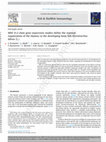
Fish & shellfish immunology, 2015
MHC II-β chain gene transcripts were quantified by real-time PCR and localised by in situ hybridi... more MHC II-β chain gene transcripts were quantified by real-time PCR and localised by in situ hybridization in the developing thymus of the teleost Dicentrarchus labrax, regarding the specialization of the thymic compartments. MHC II-β expression significantly rose when the first lymphoid colonization of the thymus occurred, thereafter increased further when the organ progressively developed cortex and medulla regions. The evolving patterns of MHC II-β expression provided anatomical insights into some mechanisms of thymocyte selection. Among the stromal cells transcribing MHC II-β, scattered cortical epithelial cells appeared likely involved in the positive selection, while those abundant in the cortico-medullary border and medulla in the negative selection. These latter most represent dendritic cells, based on typical localization and phenotype. These findings provide further proofs that efficient mechanisms leading to maturation of naïve T cells are operative in teleosts, strongly rem...
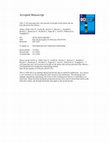
Developmental and comparative immunology, 2014
The gills of fish are a mucosal tissue that contains T cells involved in the recognition of non-s... more The gills of fish are a mucosal tissue that contains T cells involved in the recognition of non-self and pathogens, and in this work we describe some features of gill-associated T cells of European sea bass, a marine model species. A whole transcriptome was obtained by deep sequencing of RNA from unstimulated gills that has been analyzed for the presence of T cell-related transcripts. Of the putative expressed sequences identified in the transcriptome, around 30 were related to main functions related to T cells including Th1/Th2/Th17/Treg cell subpopulations, thus suggesting their possible presence in the branchial epithelium. The number of T cells in the gills of sea bass, measured with the specific T cell mAb DLT15 range from 10% to 20%, and IHC analysis shows their abundance and distribution in the epithelium. Leukocytes from gills are able to proliferate in the presence of lectins ConA and PHA, as measured by flow cytometry using CFSE fluorescence incorporation, and during proli...

Molecular immunology, 2014
In fish, the first line of defense is represented by the innate immune system and the lysozyme is... more In fish, the first line of defense is represented by the innate immune system and the lysozyme is one of the molecules involved in this mechanism of protection. Three types of lysozymes have been identified in metazoan, the c-type (chicken or conventional), the g-type (goose-type) and the i-type (invertebrate type). They are all involved in the hydrolysation of the bacterial cell wall. Our work has been focused on the molecular characterization, expression analysis by real-time PCR, both at basal condition and after in vivo challenges, and 3D structural studies on the g-type lysozyme from sea bass (Dicentrarchus labrax L.). Moreover, a recombinant sea bass lysozyme has been produced in Escherichia coli and used to investigate the activity of the enzyme at different pH and temperatures and to perform antibacterial assays against typical fish pathogens. The cloned sea bass cDNA for g-type lysozyme (accession number FN667957) consists of 742 bp and translates for a putative protein of ...
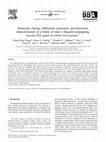
Two cDNAs and their corresponding genes (GhUBC1 and GhUBC2) encoding ubiquitin-conjugating enzyme... more Two cDNAs and their corresponding genes (GhUBC1 and GhUBC2) encoding ubiquitin-conjugating enzymes (E2s) have been cloned and characterized from allotetraploid cotton Gossypium hirsutum ((AD) 1 genome). Three additional E2 genes (GaUBC1, GtUBC2, and GrUBC2) have also been identified from diploid cottons Gossypium arboreum (A 2 genome), Gossypium thurberi (D 1 genome), and Gossypium raimondii (D 5 genome), respectively. The derived amino acid sequences of the five closely related cotton E2s are 77 -79% identical to yeast ScUBC4 and ScUBC5. The GhUBC1/2 gene family is composed of two members, and genomic origin analysis indicates that GhUBC1 and 2 are individually present in the A and D subgenomes of G. hirsutum. The transcript levels of GhUBC1/2 increased significantly in leaves and flowers at senescence, suggesting that GhUBC1/2 may play a role in the degradation of target proteins that function in the delay of the senescence program. Correlated with high auxin content and auxin-associated effects, GhUBC1/2 are also highly expressed in the youngest leaves, the apical part of lateral roots, and elongating fibers. Genetic complementation experiments revealed that GhUBC1 and 2 can substitute for the function of ScUBC4 and 5 required for the selective degradation of abnormal and short-lived proteins in a yeast ubc4ubc5 double mutant. D
Results in Immunology, 2011
and sharing with colleagues.
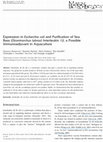
Interleukin 1b (IL-1b) is a pleiotropic cytokine that plays a pivotal role in regulating immune r... more Interleukin 1b (IL-1b) is a pleiotropic cytokine that plays a pivotal role in regulating immune responses. Our group has recently cloned IL-1b from sea bass (Dicentrarchus labrax), one of the main Mediterranean aquacultured fish species. The cDNA is 1292 bp and codes for a deduced peptide of 29.4 kDa with a pI of 5.1. As for trout and carp IL-1b precursor sequence, no candidate cut site for ICE (IL-1b converting enzyme) enzyme was apparent in the alignments of sea bass IL-1b with other mammalian IL-1bs. Nevertheless, a possible mature peptide could start at Ala 86 , giving a protein of 176 amino acids. The nucleotide sequence coding for this polypeptide was cloned into a pQE-30 expression vector. The plasmid was then transformed in Escherichia coli, and the recombinant protein was purified. Finally, we demonstrated that this purified recombinant IL-1b was able to induce IL-1b gene expression in a dose-dependent manner on cells purified from sea bass head kidney and could have immunoadjuvant effects in sea bass vaccination experiments.
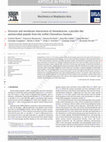
Biochimica et Biophysica Acta (BBA) - Biomembranes, 2015
a b s t r a c t 9 Cnd) is a 22-residue peptide of the piscidin family expressed in the gills of t... more a b s t r a c t 9 Cnd) is a 22-residue peptide of the piscidin family expressed in the gills of the Chionodraco 23 hamatus as protection from bacterial infections. Here, we report the effects of synthetic Cnd on both Psychrobacter 24 sp. TAD1 and Q5 Escherichia coli bacteria, as well as membrane models. We found that Cnd perforates the inner and 25 outer membranes of Psychrobacter sp. TAD1, making discrete pores that cause the cellular content to leak out. 26 Membrane disruption studies using intrinsic and extrinsic fluorescence spectroscopy revealed that Cnd behaves 27 similarly to other piscidins, with comparable membrane partition coefficients. Membrane accessibility assays and 28 structural studies using NMR in detergent micelles show that Cnd adopts a canonical topology of antimicrobial 29 helical peptides, with the hydrophobic face toward the lipid environment and the hydrophilic face toward the 30 bulk solvent. The analysis of Cnd free energy of binding to vesicles with different lipid contents indicates a 31 preference for charged phospholipids and a more marked binding to native E. coli extracts. Taken with previous 32 studies on piscidin-like peptides, we conclude that Cnd first adsorbs to the membrane, and then forms pores 33 together with membrane fragmentation. Since Cnd has only marginal hemolytic activity, it constitutes a good 34 template for developing new antimicrobial agents. 35 j o u r n a l h o m e p a g e : w w w . e l s e v i e r . c o m / l o c a t e / b b a m e m Please cite this article as: C. Olivieri, et al., Structure and membrane interactions of chionodracine, a piscidin-like antimicrobial peptide from the icefish Chionodraco hamatus, Biochim. Biophys. Acta (2015), http://dx.79 human erythrocytes, with a~0.8% percentage of hemolysis at 50 μM [4], 80 making it a promising template to develop new molecules with antimi-81 crobial activity. Cnd's primary sequence is remarkably similar to that of 82 other peptides belonging to the piscidin family, sharing the two N-83 terminal phenylalanines, the central glycine, and three histidines 84 (Fig. 1). Although we have described the gene sequence, localization 85 as well as the bactericidal activity of Cnd, we had yet to determine its 86 interactions with prokaryotic cell membranes as well as the molecular 87 and structural features of this peptide in membrane mimetic 88 environments. 89 Here, we report the membranolytic properties and structural char-90 acterization of Cnd using transmission electron microscopy (TEM), cell 91 permeation assays, and NMR spectroscopy. We found that Cnd interacts 92 with cell membranes, disrupting the inner and outer membranes of 93 both Psychrobacter sp. TAD1 and E. coli bacteria. In particular, TEM 94 images reveal that Cnd forms well-defined pores in the bacterial mem-95 branes. Moreover, experiments carried out with synthetic membranes 96 reveal a small but significant preference for negatively charged lipid 97 membranes and a more marked affinity for E. coli bacteria membranes. 98 The three-dimensional structure of Cnd is very similar to that of the 99 piscidin-1 peptide, adopting a canonical amphipathic helix, with hydro-100 phobic amino acids adsorbed on the membrane surface and the hydro-101 philic amino acids pointing toward the bulk solvent. Taken together, the 102 helical propensity (disorder to order transition), membrane binding as-103 says, and TEM images show the formation of discrete pores as well as 104 membrane fragmentation that enable the cellular content to leak out 105 and killing the cells. 106 2. Material and methods 107 2.1. Peptide synthesis 108 The Cnd peptide (N95%) FFGHLYRGITSVVKHVHGLLSG was purchased 109 from United Biosystems Inc., USA. Peptide concentration was deter-110 mined by light absorption at 280 nm before each sample preparation. 111 2.2. Lipid vesicle preparation 112 LUVs (Large Unilamellar Vesicles) of the appropriate lipid or lipid 113 mix suspension were prepared by extrusion with an Avanti Polar 114 mini-extruder through a polycarbonate membrane with pore sizes of 115 100 nm. Lipid vesicles were composed of 1-palmitoyl-2-oleoyl-sn-116 glycero-3-phosphocholine (POPC), mixtures of POPC and 1-palmitoyl-117 2-oleoyl-sn-glycero-3-phosphoglyceol (POPG), or E. coli B extract, 118 ATCC 11303, comprised of 57.5% PE, 15.1% PG, 9.8% cardiolipin (CA), 119 and 17.6% unknown (Avanti Polar Lipids Inc.). All the lipid vesicles 120 were prepared as reported in the following sections.
Italian Journal of Zoology, 2000
The immunoglobulin content in sera of red‐blooded Antarctic species (Trematomus pennelli, T. lepi... more The immunoglobulin content in sera of red‐blooded Antarctic species (Trematomus pennelli, T. lepidorhinus, Gymnodraco acuticeps, and Cygnodraco mawsoni) and of icefish (Cryodmco antarcticus, Chaenodraco wilsonii, and Pagetopsis macropterus) was determined by indirect ELISA assay with a polyclonal antiteleost immunoglobulin antibody. Electrophoretic mobilities of immunoglobulin heavy and light chains were assessed by sodium dodecyl sulfate‐polyacrylamide gel electrophoresis. The immunoreactivity of these
Haemocytes of the stick insect, Bacillus rossius, consist of at least two cell populations, granu... more Haemocytes of the stick insect, Bacillus rossius, consist of at least two cell populations, granulocytes and plasmatocytes, which can be distinguished on the basis of morphological and functional criteria. In this work, we describe quantitative analyses of adult insect haemocyte populations by flow cytometric analysis and immunofluorescence. Two populations were identified on the cytogram and classified on the basis of

Lymphoid cell subpopulations involved in allograft rejection in the teleost Dicentrarchus labrax ... more Lymphoid cell subpopulations involved in allograft rejection in the teleost Dicentrarchus labrax were characterised at the ultrastructural level and quantified by using monoclonal antibodies against T- and B-lymphocytes. T-cells positive for T-cell receptor beta-chain (TcR beta) were detected by reverse transcription/polymerase chain reaction (RT-PCR) and in situ hybridisation by using RNA probes for TcR beta. Flow cytometry detected a similar percentage of T- and B-lymphocytes (around 17%) in the leucocyte-enriched fraction from allografts. Two different types of T-lymphocytes (DLT 15-immunoreactive) infiltrating the allografts were identified by cytomorphology: small cells with high nuclear/cytoplasmic ratio and cells with a higher cytoplasmic content. RT-PCR revealed a single band (513 bp) corresponding to the TcR beta. In situ hybridisation showed that TcR beta-positive cells in the grafted muscle fibres were less numerous compared with DLT 15-positive cells, as evidenced in parallel sections, suggesting that cytotoxic cells might express different TcR phenotypes. DLIg 3-immunoreactive Ig-producing lymphocytes had: 1) a high nuclear/cytoplasmic ratio or 2) a larger size similar to that of pre-plasma cells (plasma cells lacked any membrane labelling).
A veratryl alcohol oxidase (VAO) enzyme was di~overod in cultures of PleuroUt~ ostreatus. The enz... more A veratryl alcohol oxidase (VAO) enzyme was di~overod in cultures of PleuroUt~ ostreatus. The enzyme, which oxidizes veratryl alcohol to veratraldehyde reducing O, to H20 2, was purified to homogeneity and its main structural and catalytic properties have been determined. The enzyme is a glycoprolein and contains FAD as a prosthetic group. The amin~ acid composition and carhoxy-and amino-termi-al sequences were determined. Primary aromatic alcohols with methoxy substituents in position four are good substrates for VAO; cinnamyl alcohol is the substrate which is oxidized faster whereas coniferyl alcohol is oxidized at a slower rate. The enzyme is moderately thermostable (tl/~ssocl about 1.5 h, apparent melting temperature about 60 ° C). The enzyme stability in 50% water/organic .~olvents mixtures has also been studied.
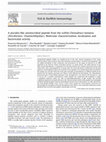
Antimicrobial peptides (AMPs) are considered one of the most ancient components of the innate imm... more Antimicrobial peptides (AMPs) are considered one of the most ancient components of the innate immune system. They are able to exert their protection activity against a variety of microorganisms, and are widely distributed in both vertebrates and invertebrates. In this paper we focused on an AMP identified in the Antarctic teleost Chionodraco hamatus, an icefish species. The cDNA sequence of the AMP, named chionodracine, is comprised of 515 bp and translates for a putative protein precursor of 80 amino acids, with a signal peptide of 22 amino acids. The structural features evidenced in the primary sequence of chionodracine lead to the inclusion of the peptide in the antimicrobial family of piscidins. The analysis by real-time PCR of the basal gene transcripts of chionodracine in different icefish tissues showed that the highest expression was found in gills, followed by head kidney. The chionodracine expression levels in head kidney leukocytes were up-regulated in vitro both by LPS and poly I:C, and in vivo by LPS. A putative chionodracine mature peptide was synthesized and employed to obtain a polyclonal antiserum, which was used in immunohistochemistry of gills sections and revealed a significant positivity associated with mast cells. The bactericidal activity of the peptide was investigated and found significant against Antarctic psychrophilic bacteria strains (Psychrobacter sp. TAD1 and TA144), the Gram-positive Bacillus cereus, and at a lesser extent against the Gram-negative Escherichia coli. Interestingly, the haemolytic activity of chionodracine was tested in vitro on human erythrocytes and no significant lysis occurred until peptide concentration of 50 mM.

Uploads
Papers by Francesco Buonocore